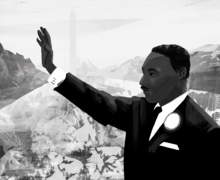Sounds of silence: Senior capstone project tackles seriousness of bullying through visually appealing orchestra performance
Luke Rafferty | Asst. Photo Editor
Guy Johanson plays the tuba in "Uncommon Action: An Interdisciplinary Arts Performance on Ally Involvement" on Sunday. The performance was Rachel Dentinger's Renee Crown Honors capstone project.
The trombonist circled the cellist, taunting the cello player with booming sounds and playing the instrument with a punching motion.
The two musicians, as part of a narrative orchestra performance, told the story of a student suffering from bullying in “Uncommon Action: An Interdisciplinary Arts Performance on Ally Involvement,” held Sunday afternoon at CNY Jazz Central in downtown Syracuse.
Rachel Dentinger, a senior music education major, conceptualized “Uncommon Action” for her Renée Crown Honors capstone project. Through the performance, Dentinger said she wants to encourage her future students to be more than mere bystanders to bullying.
Recalling the long, boring music recitals she sat through as a child, Dentinger said she wanted to create a visually appealing performance for younger students that would convince them to act against bullying. She visualized the instrumentalists moving and began to think about adding a theatrical component to the music.
“I wanted the audience to see a glimmer or character in each of them,” Dentinger said.
Last summer, Dentinger started collaborating with composer Eric Maine and choreographer Anthony Wright, a junior Spanish and television, radio and film major, to create the original music and movement. Rehearsals began in September and the ensemble performed their two showings Sunday at 2 and 4 p.m.
The performance of “Uncommon Action” was inspired by a four-part poem Dentinger wrote of the same name. The performance was separated into two acts, each with the same four sections: “Initial Conflict,” “The Struggle,” “Alone” and “If You Were There.” Each song had a distinct mood, telling a melancholic story of a bullied student.
The first act was a seated performance, where all of the instrumentalists wore black. During intermission, Dentinger encouraged the audience to reflect on their experiences with bullying. Around the room, posters were plastered to the wall with questions: “What does it mean to be an active ally?” and “What do you think happens to someone once they’ve been bullied?”
In the second act, Dentinger changed the definition of a traditional music recital, transforming it into a different experience — one that is living, moving and colorful. She recited parts of her poem before each song transition. The ensemble performed the same music as in the first act, but this time with motion.
“When they added the movement, the emotion multiplied tenfold,” said Terry Dentinger, Dentinger’s mother. “I was so moved. By the end, I was crying.”
The instruments restricted the players’ motion, so Wright, the choreographer, needed to get creative.
“We had to make up for it in a way that was still aesthetically pleasing,” he said. “The violinists’ bows going up and down made them more scary.”
Along with dance, the second act incorporated other theatrical elements, such as lighting and mixing cool and warm colors. Every instrumentalist played a character, wearing symbolic colors of red, gray and teal.
The string and brass instruments — including two violins, a viola, a trumpet, a French horn, a trombone and a tuba — wore red to represent the bullies. The wind instruments — including the piccolo, flute, oboe, clarinet and bassoon — wore gray to represent passive onlookers. Brian Savage, the victim and cellist, wore a teal sweater along with his active ally, the alto saxophonist.
Eamonn O’Neill, a freshman violin performance major and anti-bullying advocate, found that staying in character was challenging.
“It was weird being the bully,” he said. “I had to be mean to Brian with my violin, and I like Brian.”
Throughout the piece, the victim stared into the audience, wordlessly asking the crowd to reflect on bullying.
George Williams, O’Neill’s father, said he connected to the piece. It caused him to flash back to when he was a 12-year-old boy who didn’t realize he was a bully.
“When I was growing up, I lived in a neighborhood where everything was settled by a fight,” he said. “Kids knew that I could beat them up, so they always did what I wanted to do.”
One day, Williams and a team of his friends chased a classmate up to the roof of a building. The boys taunted the student from below, until he threw a large rock that hit Williams’ head, sending him to the emergency room. The next day at school, Williams reported the incident to the principal, yet he received a response he didn’t expect.
“I’m glad he hit you with it,” Williams recalled the principal saying. “You’re a bully.”
Fifty years later, “Uncommon Action” triggered that memory.
“I saw the rejection of the victim in the show, and it brought it all back,” Williams said.
At the end of “If You Were There,” the ensemble left the victim one by one until Savage, the cellist, was the only one on stage. The lights faded to black and the bass drummer pounded two beats on the drum, representing the victim’s heartbeat. A profound silence followed that signified the character ending his life.
Dentinger hopes to bring the performance to students by touring schools. Because of the piece’s address to suicide, she said it was aimed toward middle school students and above.
Elisa Dekaney, Dentinger’s honors advisor, said she was proud of Dentinger’s diligence and creativity.
“When you’re discussing ideas, you don’t know how they’re going to materialize,” she said. “But Rachel has envisioned a different way we can package the same old song.”
Published on February 4, 2013 at 12:58 am
Contact Leanna: lmgarfie@syr.edu





